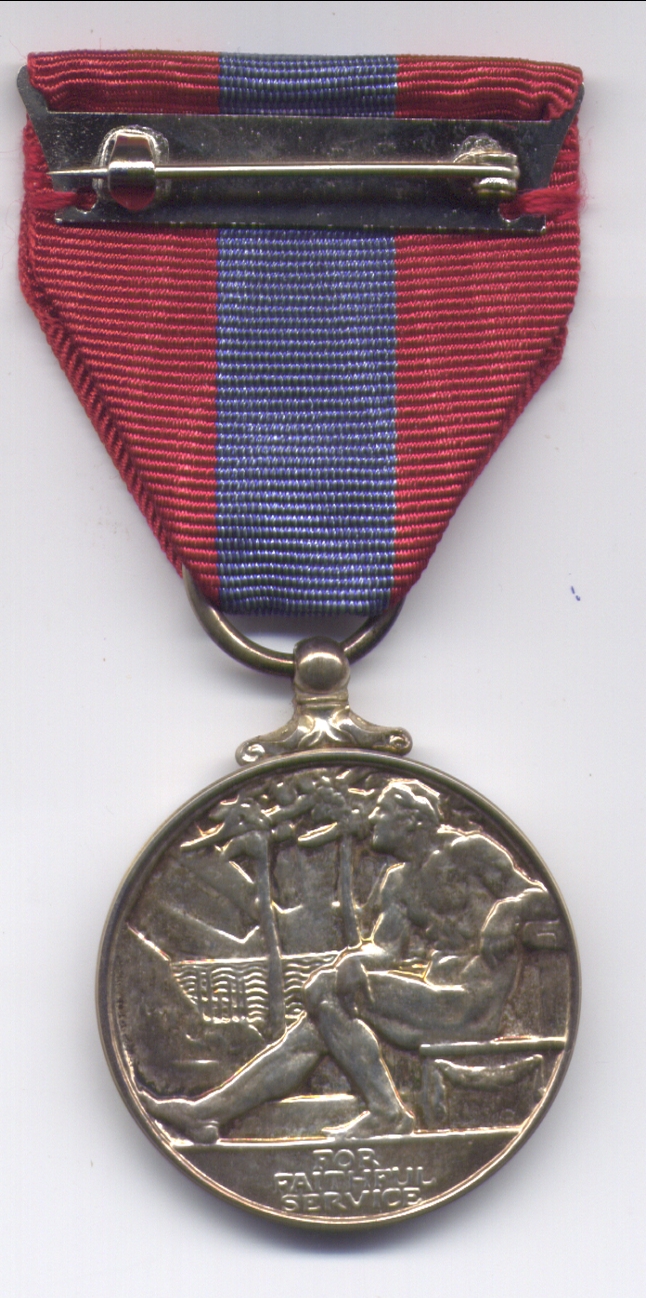
Imperial Service Medal awarded to W. Neville Fox for faithful service in the Post Office: entry includes The Buckley Society Magazine Issue Twenty Nine, Spring 2005, The Buckley Telephone Exchange by Graham Johnson"

1985
MEDAL TEXT
For Faithful service
OBVERSE - Queen's head
TEXT
Elizabeth II
Dei Gratia Regina F. D.
***********************
See 184.26 for a photograph of Neville Fox receiving his Imperial Service Medal
THE BUCKLEY TELEPHONE EXCHANGE (1936-2007)
by Neville Fox
July 2007
Prior to 1936 telephones in Buckley were connected to the exchange situated in a private house near to Daisy Hill. This was Number 107, Brunswick Road. The occupants were Lilian Johnson and her brother, Fred. The exchange operator in the day was Lilian, at night it would be Fred. 24/7 as we say today.
You only had to lift the telephone handset to be connected to your required number. This was because the system was "manual" and run by the Post Office. The opening phrase was "Number, please?", local calls being connected via flexible cords and a "ring" key on the switchboard situated in the front room. Non-local calls would be via an operator in Chester telephone exchange over "junction" and "trunk" lines to all parts of the U.K. (Incidentally, Chester was not made automatic until 1948).
In the 1920s and 1930s, I remember motorcycles with sidecar and ladder attached, parked on the side of the road outside the exchange every morning - linesmen testing and maintaining subscribers' lines. As a young lad I was enthralled with all the activity, and on leaving school I applied to The Telephone Manager for a job!
However in 1936 a new brick building went up on Daisy Hill with an entrance from Number 88, Brunswick Road. This was to be the home of a UAX (Unattended Automatic Exchange) with a capacity of 200 lines. This proved totally inadequate. With Buckley expanding at a vast rate and industrial development, more and more telephone lines were wanted, so that by the end of war in 1946, the telephone exchange was full. Temporary innovations such as party lines did little to help.
The exchange had to be extended and the equipment doubled to 400 lines - this again proved not enough. The demand for telephones was increasing all the time. As a temporary measure a new telephone exchange was rolled in! Yes, in a caravan! What name did they give it but "Spon Green". I wonder who thought of that? Fancy "Spon Green" on Daisy Hill! Where the caravan had to be parked!
The caravan was equipped with modern gear similar to Buckley UAX, and was indeed a telephone exchange in itself. But a site had to be found for it to be parked; also they wanted land for a new larger telephone exchange.
This is where Post Office Telephones became lucky. Slum clearance in Lodging House Lane had taken place. This was immediately south of the existing UAX and in an ideal spot. I knew the gentleman who had purchased the demolished site and he had paid £200 for it, so they wanted to negotiate a price. How much? They readily agreed £400! Nice deal, Bill! That gentleman was Mr. William Chirgwin. All parties thought they had made a good deal.
Nowadays, year 2007, with modernisation and digital systems in operation, the telephone exchange on Daisy Hill has been expanded and provides connection to many thousands of telephone lines and broadband subscribers. It seems that every other house in Buckley has a computer - all connected via the telephone exchange on Daisy Hill. Gone are the large wooden poles with 8-way arms (see photo - 184.18 ) carrying bare copper wires which were prominent along the main streets, between the two world wars. Now we have every private house or business customer fed by underground cable or "drop wire" from "ring" type D.P.s (distribution poles). There are hundreds but Number One still stands proudly outside Number 107, Brunswick Road. see 204.1 for an image of Number One (still standing 8.2007).
POSTSCRIPT
Chester technicians, Jack Clays, Norman Bennett and Frank Darlington (now all deceased) installed the new modern equipment in 1936 using a new 2000 type of Two Motion Electro-Mechanical selectors, also using a new 3000-type relay. This was the first modern type used in North Wales and Chester District. Ken Gregory (Chester), Ivor Hopwood (Mynydd Isa) and Brian Hopwood (Ewloe) were maintenance engineers throughout the war years (1939 -1946).
W. R. Inch (Chester Road) served as an apprentice before the war called him up to serve in the army signal corps. I worked with Buckley men W. R. Inch, J. G. Reynolds and J. K. Lewis on installation and maintenance of telephones.
Later, Bill (Inch) and Jack (Reynolds) became specialists on installation and maintenance of teleprinters; they and Ken Lewis finished their service with British Telecom (B.T.). Also, Dave Wilson, Steve France and Drury men, K. J. Davies (Ken) and G.Astbury (Glyn), served B.T. as maintenance engineers in later years.
I, myself, worked over 41 years (1940 - 1985; except for 1942 - 1946 War service) for The Telephone Service of P.O. Telephones and B.T. I worked all over North Wales on Automatic Telephone Systems, retiring at Flint A.T.E. in 1985. They even presented me with a medal (Imperial Service Medal) "for faithful service".(see inscription above)
Author: Fox, W Neville
Tags
Year = 1985
Gender = Male
Object = Other
People = Single
Work = Public Service
Copyright © 2015 The Buckley Society